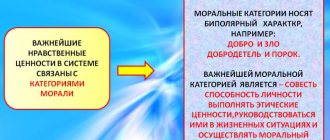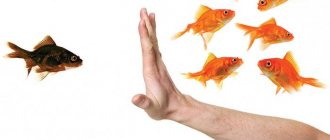Landmark, position, principles
A moral guideline is the goals and prohibitions (existing in the mind) that a person uses as a model for constructing a line of behavior.
Those. a moral guideline represents a clear framework beyond which a person does not allow himself to go.
Moral position is an assessment of the norms of social behavior and their compliance. A person passes this assessment through an internal “filter”, realizing it and accepting it as a guide for his own actions. Moral position includes:
- behavioral motives,
- self-regulation and control of one’s own actions,
- conscientiousness,
- a sense of human dignity (from the position of a person who has chosen a certain moral position for himself).
Moral principles are the framework on which social and interpersonal relationships are built.
At the same time, it is fair to assert that moral principles are universal, support social foundations through an external mechanism of influence (public approval or censure of behavior patterns), and can be expressed in moral norms.
Means and methods of moral education
Moral education is carried out using certain means and methods .
Means of moral education of preschool children can be combined into several groups.
Fiction, visual arts, music, cinema, filmstrips and other media can be combined into a group of artistic media. This group of means is very important in solving problems of moral education , as it contributes to the emotional coloring of cognizable moral phenomena. Numerous studies (N. S. Karpinskaya, L. N. Strelkova, A. M. Vinogradova) show that children vividly, emotionally and trustingly perceive fairy tales, poems, stories read to them , and look at illustrations for books (V. A. Eliseeva, G. N. Panteleev). A child is strongly impressed by the work of artists if they depict the world realistically and understandably for a preschooler . Artistic means are most effective in forming moral ideas and cultivating feelings children .
The means of moral education of preschool children is nature . Nature makes it possible to evoke humane feelings in children , a desire to take care of those who are weaker, who need help, to protect them, and helps to build self-confidence in the child. The impact of nature on the moral sphere of children’s personality is multifaceted and, with appropriate pedagogical organization, becomes a significant means of educating feelings and behavior (S. N. Nikolaeva, L. G. Niskanen, V. G. Fokina, V. D. Sych).
The means of moral education of preschoolers children’s own activities : play, work, learning, artistic activity. Each type of activity has its own specifics, performing the function of a means of education , but this means - activity as such - is necessary, first of all, when developing the practice of moral behavior . A special place in this group of means is given to communication, if, following the psychologists (M. I. Lisina, A. G. Ruzskaya), it is considered a type of activity. Communication as a means of moral education best fulfills the task of adjusting ideas about morality and cultivating feelings and relationships .
The means of moral education can be the entire atmosphere in which the child lives: the atmosphere can be imbued with goodwill, love, humanity or cruelty, immorality . The environment surrounding the child becomes a means of educating feelings , ideas, behavior, i.e. it activates the entire mechanism of moral education and influences the formation of certain moral qualities .
The choice of means of education depends on the leading task, on the age of the students , on the level of their general and intellectual development, on the stage of development of moral qualities (we are just beginning to form a quality, or are consolidating it, or are already re-educating ). As you know, the remedy becomes effective in combination with adequate methods and techniques of education .
In pedagogy, there are several approaches to the classification of educational methods (Yu. K. Babansky, B. T. Likhachev, I. P. Podlasy - in general and school pedagogy; V. G. Nechaeva, V. I. Loginova - in preschool pedagogy ) . To classify methods, researchers determine one basis. Thus, Academician B. T. Likhachev proceeds from the logic of the integrity of the pedagogical process, as well as the logic of its organization when solving problems of moral education and self-education .
According to this basis, he distinguishes three groups of methods : methods of organization and self-organization of the educational team (collective perspective, collective game, competition, common requirements); methods of trusting interaction ( method of respect , pedagogical requirement, persuasion, discussion, conflict situations); methods of influence (clarification, stress relief, dream actualization, appeal to consciousness, feeling, will and action). V. G. Nechaeva distinguishes two groups of methods of moral education of preschool children : organization of practical experience of social behavior ( training method , demonstration of action, example of adults or other children , method of organizing activities); moral ideas in (conversations, reading works of art, viewing and discussing paintings and illustrations).
the method of persuasion , positive example, encouragement and punishment in both the first and second groups The classification proposed by V. I. Loginova is built on the same basis as that of V. G. Nechaeva - on activating the mechanism of moral education - but it is more complete. The author proposes to combine all methods into three groups .
Human qualities: list
Morality and ethics intersect, forming a single system of qualities. This category includes the moral block:
- love for people
- respect for others,
- devotion (loyalty),
- selfless beginning (motivation to act due to good intentions rather than potential gain),
- spirituality (combination of morality and religiosity).
And the moral block :
- call of Duty,
- responsibility,
- honor,
- conscience,
- desire for justice
- dignity.
In addition to positive moral qualities, there are also negative ones : anger, envy, deceit, etc.
If the level of morality in a society is low, over time, negative actions and qualities become acceptable and preferable for society, and are then instilled in younger generations as the current norm.
The substitution of concepts occurs very quickly and the dynamics can be tracked even using the example of children and their parents.
A positive moral quality is recognized as such at the level of entire communities. And such universal qualities guarantee that their owner will be identified as a moral and educated person.
The most highly valued in modern society are responsibility, humanity, openness, sincerity, discipline, loyalty, collectivism, tact, hard work, diligence, and cleanliness.
High moral qualities are those qualities that are in the “positive” pole in a given society/culture.
But in some cases , “high” are those qualities that are dictated not so much by the need to successfully integrate into society, but by the deep and sincere feelings of an individual. This category includes patriotism, chastity, and absolute humanism.
Moral formation of personality. article (grade 8) on the topic
Moral formation of personality
The moral formation of personality is a complex and multifaceted process carried out under the influence of various factors and conditions. The younger generation develops under the influence of external and internal influences. Everything that children come into contact with - people, things, phenomena of the surrounding life - leaves an imprint on their behavior, on their moral character.
Moral education should be focused on the requirements of our life not only in the present, but also in the future. An important section is the education of moral and volitional character traits: honesty and truthfulness, moral purity, simplicity and modesty in public and personal life, respect for elders.
Already from childhood, one should cultivate an intolerant attitude towards injustice, dishonesty, and negative qualities and actions that interfere with building a new society.
The need for moral education of children is due to several reasons. First, children are not born moral or immoral. They become like this in the process of purposeful education. Secondly, in order to master moral experience, children need constant help from adult teachers who already have this experience. Children's personal experience is very narrow and limited. Hence the need for systematic education aimed at developing positive moral qualities and overcoming negative ones. Any qualities of a personality, the level of its intellectual development, physical perfection, willpower have a positive social meaning only in combination with the moral development of the individual.
It is important for the teacher to understand how moral education influences the development of the student, how the student changes and rises to a new level of moral perfection. This can be understood if we divide the holistic process of moral education into separate links and consider each of them.
So, let's consider the processes of moral development in students at all stages of education.
At primary school age, during the period of children’s own moral development, the moral sphere undergoes further changes. In elementary school, children are faced with the fact that they must constantly follow moral rules and norms, compliance with which is constantly and purposefully monitored. Younger children must constantly learn to apply these rules and norms in relationships with teachers, educators, other adults, and peers. Young children are psychologically ready to understand the meaning of all moral norms and rules. At this age, the formation of such moral feelings as a sense of camaraderie, duty, collectivism, the ability to empathize, and empathy occurs.
But the moral development of a younger schoolchild is characterized by age-related changes. At this age stage, children are not yet capable of developing their own moral convictions. While mastering moral requirements, the younger student continues to rely on the authority of parents, teachers, and older students. The relative lack of independence of moral thinking and the greater suggestibility of the younger schoolchild determine his easy susceptibility to both positive and negative influences.
Starting from adolescence, the main driving forces of moral development are biological maturation and social learning. Biological development is a necessary basis for the moral development of a teenager.
Ideals acquire the greatest importance for moral development in adolescence. Their formation is closely related to interest in the moral qualities of people, their actions, and relationships with each other. And if initially ideals arise in a child involuntarily, without a conscious search, then already in older adolescence and youth there is an active search for people whose images correspond to moral aspirations and serve as a support for moral behavior.
At high school age, moral development is characterized by the emergence of the following new functional formation - moral beliefs, representing an alloy of relevant knowledge and feelings. The student’s analyzed life experience is expressed in his beliefs. This makes their beliefs specific motives for the behavior and activities of schoolchildren, giving behavior greater stability, consistency and flexibility. With the emergence of beliefs, the ideals embodied in the image of a particular person are first rebuilt and then completely disappear. Instead of a single concrete image, a certain collective ideal arises.
High school students have the opportunity to consciously manage their behavior and strive to develop qualities that correspond to their moral views and beliefs. High school students’ desire for moral knowledge is driven by interest in their own personality.
Worldview search includes the social orientation of the individual, awareness of oneself as an element of a social community, the choice of one’s future social position and ways to achieve it. When solving the problem of the meaning of life, high school students think not so much about the question “who to be?”, but rather about the question “what to be?”.
The main processes of formation of moral development:
Formation of moral consciousness
The level of moral consciousness of an individual determines his behavior and activities. The process of forming consciousness is long and complex; it begins long before the child enters school with the formation of initial ideas about society and the relationships of loved ones.
Formation of skills and habits of behavior
The effectiveness of a teacher largely depends on how much he cares about the formation of useful skills and behavioral habits.
Skills and habits can be formed through rote training. But this way is less effective. The child does not want to consider himself only as a pedagogical phenomenon, although he knows that he is being raised by adults. Moreover, he resists education if it consists only of teachings and training.
A much more effective way of forming habits is a child’s pedagogically thought-out life. In school life, expediently organized by the teacher, many useful behavioral habits are formed unnoticed by the children themselves.
Formation of stable beliefs
- the most important task. Our children need deep ideological convictions that would give rise to strong feelings and manifest themselves in actions and deeds. Such beliefs can arise if they are not only thought out and felt by a person, but also experienced by him and confirmed by his personal experience. Therefore, the rule of a school’s activities in moral education should be not only an explanation of certain norms, but also the creation of conditions in which children could test their views, hone them, and be convinced by experience of their correctness.
It is important that the child realizes and accepts these beliefs. Only in this case can they become the motive for his behavior. Motive is a conscious impulse, it is a force that moves and directs human behavior. Without appropriate motives, the necessary forms of behavior are not consolidated, and one or another moral qualities of the child as an activist or public figure are not formed.
Formation of an internal ideal
The formation of an ideal is closely related to the emergence of such special moral feelings as self-respect and self-esteem, which become important motives of behavior and means of self-control. Thus, the essence of this stage of moral development is that the moral model that was previously given to the child from the outside, now presented in the form of an ideal, becomes internal.
Formation of moral feelings
Feelings have a huge impact on a child's behavior. Relying on feelings in education increases its effectiveness. The impact on children's feelings is immeasurable and represents the most difficult area in moral education.
When determining ways to influence a child’s feelings, it is necessary to keep in mind that the education of feelings proceeds mainly along the path of changing and further improving the child’s feelings. It is impossible, for example, to directly set a goal for a child - to experience a feeling of admiration for the actions of his friend or literary hero. In order for the necessary feeling to arise, it is important to create an appropriate environment in which the child can experience certain experiences. You can, for example, talk a lot about your native nature and not evoke in children a feeling of admiration for its beauty and grandeur. But a series of excursions into nature, setting children the task of finding the most beautiful places, photographing them, and editing them lead to the emergence in children of a feeling of love for nature. In this case, the teacher not only evokes noble feelings, but also helps to consolidate them.
The bright, rich life of the team, well organized by the teacher, is the basis for the formation of high moral feelings: love for the Motherland, a sense of duty to the team.
Moral education is a continuous process, it begins with a person’s birth and continues throughout life. At first glance, it may seem that it is impossible to identify any periods in this single continuous process. And yet it is possible and advisable. Pedagogy has recorded that at different age periods there are unequal opportunities for moral education. A child, a teenager and a young man, for example, have different attitudes towards various means of education. For the course of education, it is important to know its results, which are best summed up over a certain period of life.
Therefore, it is important to determine this level from the first days of children’s education, during constant communication with them in lessons, outside of school hours, and in conversations. But this should not lead to a break, a stop in moral education. Using new opportunities: changing the nature and organization of activities, enriching children’s knowledge, the teacher strives to expand and deepen the moral experience of children, their moral ideas and concepts. When working with the entire team, the teacher should not. does not lose sight of individual children. Having noticed positive traits and properties in a particular child, the teacher should strive to develop and improve them. The teacher must coordinate his efforts and in this way not only solve problems, but also prepare conditions for the further moral education of children.
Hours of conversation on topics:
- "Let's live in peace";
- "Educating yourself";
- "Basics of Communication";
- "Tell me about yourself";
- "Way to success";
- “The ability to live among people”;
- “Being confident is great,” etc.
Techniques:
Methodology “What is good, what is bad”
Students are asked to give examples of: principled action; the evil that others have done to them; the good deed they witnessed; a just act that a person you know did; weak-willed act of irresponsibility, etc.
The degree of formation of concepts about moral qualities is assessed on a 3-point scale:
- 1 point - the student has formed an incorrect idea about this moral concept;
- 2. points - the idea of the moral concept is correct, but not clear and complete enough;
- 3 points - a complete and clear idea has been formed.
Methodology “Diagnostics of moral self-esteem”
Instructions:
You are offered ten statements. Listen carefully to each of them. Think about how much you agree with him. If you completely agree with the statement, rate the answer 4 points; if more agree than disagree, rate the answer 2 points; If you don’t agree at all, rate the answer 1 point.
List of sayings:
- I am often kind to my peers and adults.
- It is important for me to help a classmate when he is in trouble.
- I believe that it is possible to be unrestrained with some adults.
- There’s probably nothing wrong with being rude to someone I don’t like.
- I believe that politeness helps me feel good around people.
- I think that I can allow myself to swear in response to an unfair remark addressed to me.
- If someone in class is teased, then I tease him too.
- I enjoy making people happy.
- It seems to me that you need to be able to forgive people for their negative actions.
- I think that you need to be able to forgive people for their negative actions.
Processing the results:
Numbers 3,4,6,7. (negative questions) are processed as follows: an answer scored 4 points is assigned 1 unit; 3 points - 2 units, 2 points - 3 units; 1 point - 4 units. In other answers, the number of units is set according to the score. For example, 4 points is 4 units, etc.
Interpretation:
- From 34 to 40 units - a high level of moral self-esteem.
- From 24 to 33 units is the average level of moral self-esteem.
- From 16 to 23 units - the level of moral self-esteem is below average.
- From 10 to 15 units - a low level of moral self-esteem.
Methodology “Diagnostics of ethics of behavior”
Instructions:
You are presented with five unfinished sentences. You must think and complete each of these sentences yourself.
List of offers:
- When I see one of the guys in a ridiculous situation, I:
- If someone laughs at me, then I:
- If I want to be accepted into the game, then I:
- When people constantly interrupt me, I:
- When I don’t feel like communicating with my classmates, I:
Interpretation:
- question. A negative result is manifested if the answer contains: indifference, aggression, frivolous attitude. Positive result: help, sympathy.
- question. Negative result: aggression, various methods of psychological pressure. Positive result: lack of reaction, avoiding the situation, expressing your feelings and opinions without rudeness or aggression.
- question. Negative result: pressure, aggression, cunning. Positive result: self-affirming behavior built on equal relationships, open position.
- question. Negative result: absence of any reaction, aggression, irritation, threat, pressure. Positive result: expressing your wishes, opinions, feelings, attitudes without aggression or rudeness.
- question. Negative result: rudeness, aggression, tactlessness. Positive result: tactful, soft, clear expression of your wishes.
Methodology “Diagnostics of moral motivation”
Instructions:
For each question proposed to you, there are several possible answers. Choose the one that is most characteristic of your behavior.
Judgments:
If someone cries, then I:.
A. trying to help him;
B. I think about what could have happened;
V. I don’t pay attention.
My friend and I are playing tennis, and a 6-7 year old boy comes up to us and says that he doesn’t have such a game.
A. I will tell him not to pester him;
B. I will answer that I cannot help him;
V. I will tell him to ask his parents to buy him such a game;
G. I promise that he can come with a friend and play.
If someone in the group is upset because they lost a game:
A. I won’t pay attention;
B. I’ll say that he’s a weakling;
V. I’ll explain that there’s nothing to worry about;
G. I will say that we need to learn this game better.
If my classmate is offended by me, then I:
A. I’ll think about his feelings and what I can do in this situation;
B. I will be offended in response;
V. I will prove that he is wrong.
Interpretation:
Positive answers: 1a, 2d, 3c, 4a.
The sum of positive answers is calculated:
- 4 points – high level;
- 2-3 points - average level;
- 0-1 point - low level.
Methodology "Choice"
This technique allows us to identify children’s attitude to moral standards and corresponding moral qualities (responsibility, collectivist orientation, self-criticism, conscientiousness, integrity, sensitivity, justice). Children are asked to complete the following tasks:
During the holidays, when you were getting ready to go on vacation, the teacher unexpectedly asked you to help put the group in order. What will you do?
A) Say that you agree to help and postpone your departure;
B) Gather the guys and together with them you will do the work in one day;
C) You will promise to do the work after returning.
D) You will advise to attract help from someone who will remain in the village.
2. You have been assigned a task that is not entirely to your liking, but its implementation is urgently needed by the team. What will you do?
A) Carry out the instructions in good faith;
B) You will involve your comrades in carrying out the assignment, so as not to do the work yourself;
C) Ask to give you another, more interesting job for you;
D) you will find an excuse for refusal.
3. You accidentally heard that your friend’s group made a fair, but unpleasant remark about you. What will you do?
A) You will try to explain to the guys what caused the mistakes in your behavior;
B) You will turn the conversation into a joke, but you will try to quickly correct the shortcomings that were discussed;
B) Pretend you didn’t hear anything;
D) Point out to the guys that they themselves are no better than you, especially because they talk about you in your absence.
4. While weeding vegetables in the labor camp, painful calluses developed on your hands. What will you do?
A) You will, overcoming the pain, fulfill the norm, like everyone else;
B) Turn to your friends with a request to help you fulfill the quota;
C) ask to be released from work and transferred to another;
D) Leave the work unfinished and go to rest.
5. You witnessed how one person undeservedly offended another before your eyes. What will you do?
A) You will demand an apology from the offender to the victim;
B) You will understand the causes of the conflict and achieve its elimination;
C) Express condolences to those who were offended;
D) Pretend that this does not concern you.
6. You accidentally, without meaning to, caused minor damage or harm to another person. What will you do?
A) You will do everything impossible to eliminate evil and damage;
B) Apologize and explain to the victim that you didn’t mean to do this;
C) You will try so that no one notices the damage you have caused, you will pretend that you are not to blame;
D) You put the blame on the one who suffered: don’t let him interfere, it’s your own fault.
Processing of received data:
Choosing answer “a” indicates an active, stable positive attitude towards the relevant moral standards and is scored 5 points. Answer “b” shows that this attitude, although active, is not stable enough (compromises are possible) and is assessed at 3 points. If a student chose the answer “c” in this situation, then his attitude is passive and not stable enough and is assessed at 2 points. Finally, choosing the last answer is evidence of a child’s negative, unstable attitude towards moral standards, and is scored 1 point.
- High level - 24-30 points;
- Quite a high level - 18-23;
- Average level - 14-17 points;
- Below average - 6-13 points.
High level of moral education:
Moral standards have been well mastered and a stable attitude towards them has developed. Such valuable qualities as responsibility, conscientiousness, sensitivity, integrity, and fairness are quite fully demonstrated in behavior. During leisure hours, socially valuable experiences are mastered; activities that are useful for the spiritual development of the student and useful to those around them predominate.
Quite a high level of moral education:
In general, moral standards have been formed and a positive attitude towards them has been determined. A child’s behavior may demonstrate responsibility, sensitivity, integrity, and fairness. He spends his free time wisely, engaging in labor, artistic, and sports activities, and reads a lot.
Average level of moral education:
There is knowledge about moral standards, but the attitude towards them is not stable enough. Basic moral qualities: responsibility, sensitivity, fairness, integrity, criticality, compatibility, etc. - manifest themselves depending on the situation. In free time, along with optimal and meaningful activities, passive-contemplative and low-value forms of leisure occur.
Below average level of education:
Knowledge about moral standards is rather approximate, and the attitude towards them is passive and unstable. The basic moral qualities have not fully developed, primarily responsibility, criticality, conscientiousness, justice, sensitivity, and if they manifest themselves, then only situationally. Free time is filled spontaneously and with low-value activities, including doing nothing.
Presentation.
Behavior
Behavior becomes moral when an individual ties it to the existing system of moral values and tries to bring his actions to positive guidelines.
The key element of moral behavior is action .
An act, in turn, consists of an action and can receive a positive or negative assessment from members of society.
Abstaining from any action at a time when morality requires a person to be active can also be regarded as an act.
Moral behavior is difficult to evaluate objectively, but others always pass other people’s actions through “filter factors” :
- motives (if a noble motive led a person to an unsightly result, the degree of indignation of society will decrease),
- the result of an action
- objective reality (the circumstances in which the act was committed),
- means of achieving the task (a person can use “forbidden techniques” on the way to a good goal, which will seriously darken his moral character).
Moral behavior is always an attempt to find a balance between the restrictions established by society (framework) and one's own freedom (creative choice).
What are the standards?
Moral standards can be represented as a scale with two poles , one of which displays encouraged behavior patterns, and the other condemned.
Moral norms can be divided into two types: about what is permissible and what is unacceptable (about good and evil).
The concepts are opposite and mutually exclusive, which means that each norm has its own antipode.
This forces a person to take a stable position, since it is impossible to maintain neutrality in conditions of polarity (unless inaction is a conscious choice of a person who is ready to be condemned by others).
Relativism, what is it?
Moral relativism is a position whose proponents deny the possibility of the existence of absolute evil or good.
According to moral relativism, morality is not tied to universal standards.
Ethical behavior is only a variable value that changes as a result of changing scenery (culture, participants in the action, nuances of the situation, etc.).
Relativism can be viewed in two ways:
- the concepts of “good” and “evil” are conditional in themselves,
- public morality is conditional relative to unconditional standards of good and evil.
Briefly about the theory of moral development
How is morality formed in children? Many scientists have asked this question. But in the modern world, only Lawrence Kohlberg's theory has achieved wide recognition.
Kohlberg used the dilemma method. He projected onto children situations in which the young participants in the experiment had to make difficult moral choices.
As a result, the idea that children develop spontaneous morality, not tied to any numbers or indicators, was rejected.
Kohlberg identified three levels of development of moral consciousness:
- Age from 4 to 10 years. This level was called "pre-moral". In the period from four to ten years, a child puts his own benefit and safety at the forefront. At the first stage of development, he seeks to gain approval in order to escape punishment. And the correct tactics of behavior are easy to build with the help of tips (social norms). At the second stage, the child is already focused on potential rewards for good behavior. The kid thinks not about punishment, but about benefit.
- Age from 10 to 13 years. The level is called conventional. During this period, the child already begins to understand the rules and values accepted by society. At the first stage, the measure of moral success is people from one’s close circle. Shame and the reluctance to disappoint authority figures pushes people to follow the rules. At the second stage, the child already understands the reasons why the restrictions were introduced. He also sees them as a way to assert and protect his own rights.
- Age after 13 years. A teenager creates his own system of moral values, adjusting the template accepted by society.
At the first stage, a lot of attention is paid to those norms that help to survive and maintain peace in society. At the second stage, a person already has stable moral principles, which he adheres to despite external influences and circumstances. If necessary, the individual will be able to fight back and endure the disapproval of the crowd if the behavior of the crowd seems unfair.
Features of moral education
Moral education involves going through the first two stages of developing moral behavior before the child reaches seven years of age. Of course, the possibility of developing moral feelings and emotions at a later age cannot be ruled out, but in this case the process of developing morality will be much more difficult.
The next feature, and even complexity, of the process of moral education is the possible difference in the moral principles of educators. Moral education occurs comprehensively: in the family, in an educational institution and in society. It is very good if the moral principles in these areas of upbringing are the same, then it will not be difficult to achieve good effectiveness in raising a child, otherwise he simply ends up in a situation of dual morality.
Definition
Moral education is a special type of education in the general process of personal education. This process involves the complete and continuous immersion of the teacher in the child’s life, his support at the right moment. This process is continuous and lasts throughout adult life from birth.











